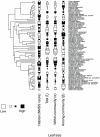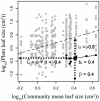Independent evolution of leaf and root traits within and among temperate grassland plant communities
- PMID: 21687704
- PMCID: PMC3110580
- DOI: 10.1371/journal.pone.0019992
Independent evolution of leaf and root traits within and among temperate grassland plant communities
Abstract
In this study, we used data from temperate grassland plant communities in Alberta, Canada to test two longstanding hypotheses in ecology: 1) that there has been correlated evolution of the leaves and roots of plants due to selection for an integrated whole-plant resource uptake strategy, and 2) that trait diversity in ecological communities is generated by adaptations to the conditions in different habitats. We tested the first hypothesis using phylogenetic comparative methods to test for evidence of correlated evolution of suites of leaf and root functional traits in these grasslands. There were consistent evolutionary correlations among traits related to plant resource uptake strategies within leaf tissues, and within root tissues. In contrast, there were inconsistent correlations between the traits of leaves and the traits of roots, suggesting different evolutionary pressures on the above and belowground components of plant morphology. To test the second hypothesis, we evaluated the relative importance of two components of trait diversity: within-community variation (species trait values relative to co-occurring species; α traits) and among-community variation (the average trait value in communities where species occur; β traits). Trait diversity was mostly explained by variation among co-occurring species, not among-communities. Additionally, there was a phylogenetic signal in the within-community trait values of species relative to co-occurring taxa, but not in their habitat associations or among-community trait variation. These results suggest that sorting of pre-existing trait variation into local communities can explain the leaf and root trait diversity in these grasslands.
Conflict of interest statement
Figures

 ), within-community (α), and among-community (β) components of leaf size variation (all values centered and scaled for visual comparison purposes). Branches are scaled proportional to estimated divergence times, with the root node (monocot – eudicot divergence) estimated at 139 million years ago.
), within-community (α), and among-community (β) components of leaf size variation (all values centered and scaled for visual comparison purposes). Branches are scaled proportional to estimated divergence times, with the root node (monocot – eudicot divergence) estimated at 139 million years ago.
 = 0.4). The solid line indicates the slope of within-species variation in leaf size in Galium boreale along the community trait gradient (bs).
= 0.4). The solid line indicates the slope of within-species variation in leaf size in Galium boreale along the community trait gradient (bs).

References
-
- Reich PB, Wright IJ, Cavender Bares J, Craine JM, Oleksyn J, et al. The evolution of plant functional variation: traits, spectra, and strategies. Int J Plant Sci. 2003;164:S143–S164.
-
- Diaz S, Hodgson JG, Thompson K, Cabido M, Cornelissen JHC, et al. The plant traits that drive ecosystems: Evidence from three continents. Journal of Vegetation Science. 2004;15:295–304.
-
- Westoby M, Wright IJ. Land-plant ecology on the basis of functional traits. Trends in Ecology & Evolution. 2006;21:261–268. doi: 10.1016/j.tree.2006.02.004. - DOI - PubMed
-
- Wright IJ, Reich PB, Westoby M, Ackerly DD, Baruch Z, et al. The worldwide leaf economics spectrum. Nature. 2004;428:821–827. doi: 10.1038/nature02403. - DOI - PubMed
-
- Ryser P. The mysterious root length. Plant Soil. 2006;286:1–6. doi: 10.1007/s11104-006-9096-1. - DOI
Publication types
MeSH terms
LinkOut - more resources
Full Text Sources

